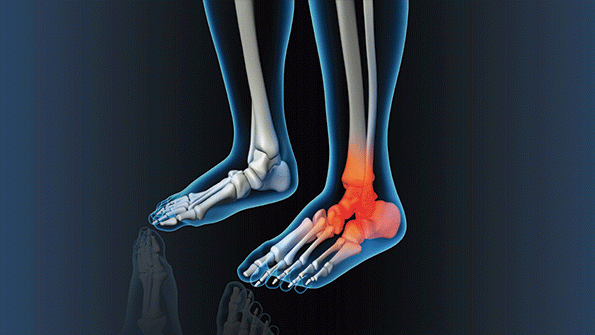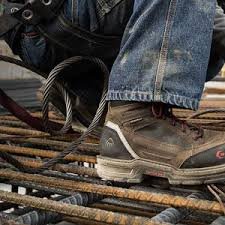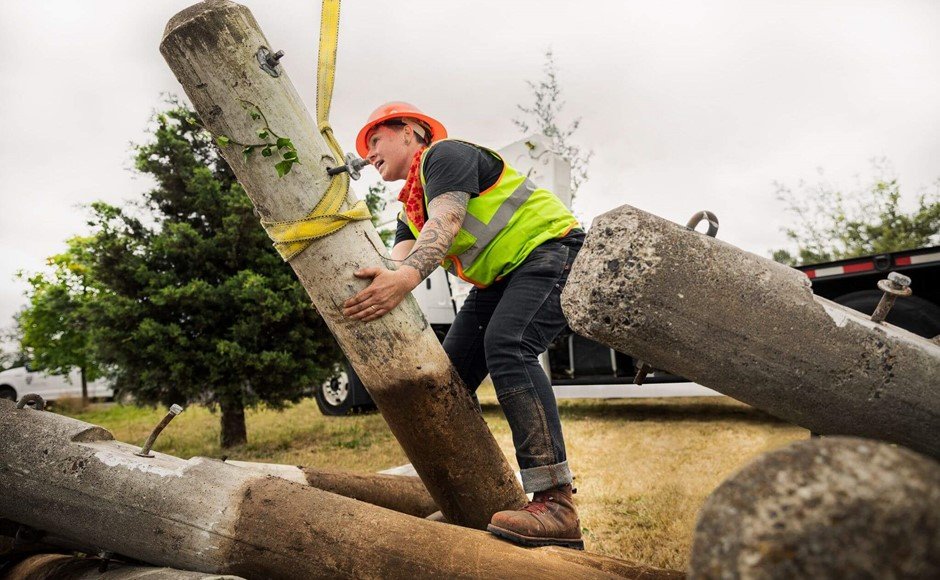While protecting workers’ feet from injury in the workplace is important, other aspects of foot protection – such as comfort and slip-resistance – also come into play.
What is in this article?
- Feet Don’t Fail Me Now! Foot Safety in the Workplace
- Footwear Facts

Have you ever noticed that there are a number of famous quotes that talk about feet? “Keep your eyes on the stars and your feet on the ground.” – Theodore Roosevelt. “Better to die on one’s feet than to live on one’s knees.” – Dolores Ibarruri. “The foot feels the foot when it feels the ground.” – Buddha. “Put your best foot forward.” – Mom.
Perhaps we talk about feet because when our feet hurt or are injured, it’s difficult to concentrate on anything else. And for all that we walk thousands of steps a day and hundreds of miles a year, our feet can be delicate and susceptible to injury; lots of injuries, in fact.
According to the Bureau of Labor Statistics, U.S. workers reported more than 110,000 injuries to feet and ankles in 2014 (the latest year for which statistics are available). These include sprains, strains, cuts, crush injuries, amputations, chemical burns and more.
There are two major categories of work-related foot injuries. The first includes injuries from punctures, crushing and lacerations. The second group of injuries includes those resulting from slips, trips and falls, such as sprains, strains and broken bones. Proper management of hazards and the use of the right foot protection and flooring dramatically can reduce work-related foot injuries.
These two categories of foot injuries, however, do not exhaust the whole range of foot problems at work, notes the Canadian Centre for Occupational Health and Safety (CCOHS), which offers an OSH Answers Fact Sheet for Foot Comfort and Safety at Work. While tired and swollen feet or calluses are not “occupational injuries,” they can impact worker comfort and production.
Foot problems occur both on and off the job, but there are certain work-related factors that can lead to foot problems. For example, standing for long hours not only tires the worker’s feet but also can cause the joints of the bones of the feet to become misaligned (e.g., cause flat feet), according to the experts at CCOHS, and can cause inflammation that can lead to rheumatism and arthritis.
A lack of supportive and appropriate protective footwear isn’t the only thing that can lead to foot injuries or discomfort. The flooring that is used in the workplace has an important influence on comfort. Hard, unyielding floors like concrete are the least comfortable surfaces to stand or walk on.
Working on a hard floor has the impact of a hammer, pounding the heel at every step, notes CCOHS in its fact sheet. Slippery floors are hazardous for slips and falls that can result in sprained ankles or broken foot bones.
Designing the Work to Fit the Worker
Footwear that fits poorly or is in need of repair is not only uncomfortable, it can lead to injury. A poorly designed job task or workspace also can contribute to foot discomfort and injuries.
Foot hazards differ according to the workplace and the types of tasks the worker does. The first step in developing a strategy to reduce foot problems is to identify the relevant hazards at the workplace.
CCOHS suggests that a hazard assessment be conducted in each workplace, with a specific emphasis on job and workplace design.
Aching, flat or tired feet are common among workers who spend most of their time standing. The most important goal of job design is to avoid fixed, standing positions, which also contribute to leg and back problems. Eliminating them whenever possible contributes to a more healthy worker in general.
Good job design includes varied tasks that require changes in body position and the use of different muscles. Job rotation, job enlargement and teamwork are all ways to make work easier on the feet, according to CCOHS.
Job rotation – Moving workers from one job to another distributes standing among a group of workers and shortens the time each individual spends standing. However, it must be a rotation where the worker does something completely different, such as walking around or sitting at the next job.
Job enlargement – Adding more and different tasks to a worker’s duties can increase the variety of body positions and motions. When this occurs, the worker has less chance of developing foot problems.
Teamwork – When the whole team is given more control and autonomy in planning and allocation of the work, then workers alternate between tasks, which reduces the risk of overloading the feet.
Rest breaks help to alleviate foot problems where redesigning jobs is impractical. Frequent short breaks are preferable to fewer long breaks.
Redesigning the Workplace
Redesigning the job alone will not reduce foot problems if it is not combined with the proper design of the workplace. Some aspects of workplace design that could reduce foot pain and injury include:
- For standing jobs, an adjustable work surface is the best choice. If the work surface is not adjustable, two solutions include installing a platform to raise the shorter worker or a pedestal to raise the object for a taller worker.
- Work station design should allow the worker room to change body position.
- A foot-rail or footrest enables the worker to shift weight from one leg to the other, reducing the stress on the lower legs and feet.
- Where possible, a worker should be able to either sit or stand while working. When work only can be done while standing, a seat should be provided for rest breaks.
- Changes to job and workplace designs also have the potential to improve foot safety in workplaces that specifically could be hazardous to feet. Some examples cited by CCOHS include:
- Separating mobile equipment from pedestrian traffic and installing safety mirrors and warning signs can decrease the number of incidents that might result in cut or crushed feet or toes.
- Proper guarding of machines such as chain saws or rotary mowers can avoid cuts or severed feet or toes.
- Effective housekeeping can reduce the number of incidents at workplaces. For example, immediately cleaning up loose nails and other sharp objects, as well as clearing littered walkways, can eliminate foot hazards.
- Using color contrast and angular lighting to improve depth vision in complicated areas such as stairs, ramps and passageways reduces the hazard of tripping and falling.
- Posting safety signs in conspicuous places where safety footwear is required when there is a potential hazard from falling objects, sharp objects, etc.
Footwear Facts
Wearing appropriate footwear definitely has saved many toes and many feet from broken bones. It also can save lives, particularly when slippery floors or stairs are an issue. By the same token, inappropriate footwear can cause or aggravate existing foot problems. Thanks to innovations in design, workers don’t have to choose between being fashionable and safe.
The best way to involve workers in programs to protect their feet is to provide them with education on foot hazards and the importance of appropriate footwear. Workers should be given the guidelines for selecting proper foot protection based on the work and the hazards found in the workplace. They also should receive information about general foot care.
In designing workplace strategies to protect foot injury, remember the fundamental principle of occupational health and safety: that occupational hazards should be eliminated at the source. The role of personal protective equipment is to minimize exposure to specific occupational hazards, and protective footwear does not guarantee total protection.
According to OSHA CFR 1910.36, “The employer shall ensure that each affected employee uses protective footwear when working in areas where there is a danger of foot injuries due to falling or rolling objects, or objects piercing the sole, or when the use of protective footwear will protect the affected employee from an electrical hazard, such as a static-discharge or electric-shock hazard, that remains after the employer takes other necessary protective measures.” Other hazards can include molten metals, hot surfaces, chemicals and wet or slippery surfaces. Protective footwear, according to OSHA, must meet ANSI Z41 or equivalent design requirements.
Jeff Goodwin, Red Wing Shoe Co.’s director of industrial business, took a look into his crystal ball and came up with these predictions for protective footwear:
Lighten up, but have purpose – “Generally speaking, lighter and more breathable materials are in high demand with no immediate signs of letting up,” said Goodwin Today’s industrial footwear manufacturers are wrestling with how to use lightweight textiles while continuing to have their products hold up.” There needs to be a balance between lightweight and traditional materials to ensure products are able to withstand harsh work environments, he added.
Greater consideration of the “toe package” – “Safety professionals are learning that non-metallic toe footwear meets the same ASTM standards as traditional steel-toe products,” Goodwin said. The decision to include or not include a metallic toe usually is driven by a functional need based on the footwear’s intended environment, said Goodwin, which significantly may affect the desired shape, weight and heat/cold transfer properties of the product.
Environment-specific footwear – Workers across several industries used to lace up the same pair of boots each day, resulting in the ubiquitous term “work boot.” “Increasingly, new materials technology and engineering ingenuity are creating an array of features that can offer enhanced flexibility, stability and performance for work environments with very unique and specific needs,” said Goodwin.
A case in point, is a new boot introduced for workers in the food and beverage processing industry.
The injected polyurethane boots combine waterproof construction with a urethane sole for slip resistance, thermal properties to stay warm in refrigerated conditions, a special chevron sole with wide channels for easy cleaning, an antimicrobial liner and varying colors to prevent cross-contamination of materials from one part of a plant to another.
Female-friendly footwear – Many PPE options, including footwear, have been sold as unisex or universal fit for years, providing women smaller sizes of footwear made for men. “As women comprise more of the industrial workplace and encounter sizing and safety hazard issues, the industry is moving from a ‘shrink it and pink it’ mentality to offering new products specifically designed for women with fit and comfort in mind,” according to Goodwin.
The use of appropriate foot protection, choosing correct flooring and designing job tasks and the workplace to eliminate static standing for employees can be a winning combination when it comes to foot safety.
And with that, I’ll leave you with one more famous quote: “Feets, don’t fail me now.” – Willie Best.
Choosing Footwear
What should employees know when buying footwear for work? According to the experts at the Canadian Centre for Occupational Health and Safety, good footwear should have the following qualities:
- The inner side of the shoe must be straight from the heel to the end of
- the big toe.
- The shoe must grip the heel firmly.
- The forepart must allow freedom of movement for the toes.
- The shoe must have a fastening across the instep to prevent the foot from slipping when walking.
- The shoe must have a low, wide-based heel; flat shoes are recommended. They also offer this advice:
- People buying footwear for work should not expect that footwear that is too tight will stretch with wear.
- Workers should have both feet measured when buying shoes. Feet normally differ in size. Buy shoes to fit the bigger foot.
- Buy shoes late in the afternoon when feet are likely to be swollen to their maximum size.
- Ask a doctor’s advice if properly fitting shoes are not available.
- Consider using shock-absorbing insoles where the job requires walking or standing on hard floors.
- When selecting footwear, remember that tight socks or stockings can cramp the toes as much as poorly fitted shoes. Wrinkled socks, or socks that are too large or too small, can cause blisters.



